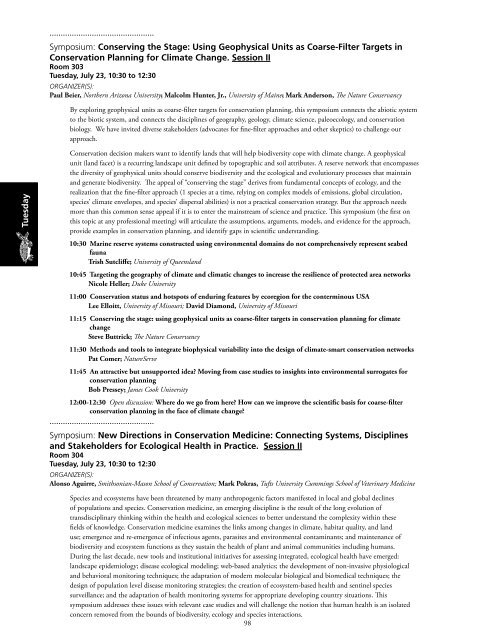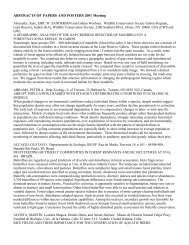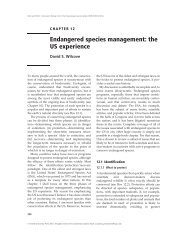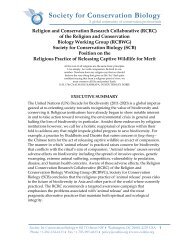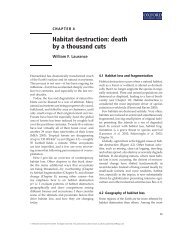ICCB 2013 Program - Society for Conservation Biology
ICCB 2013 Program - Society for Conservation Biology
ICCB 2013 Program - Society for Conservation Biology
You also want an ePaper? Increase the reach of your titles
YUMPU automatically turns print PDFs into web optimized ePapers that Google loves.
...............................................<br />
Symposium: Conserving the Stage: Using Geophysical Units as Coarse-Filter Targets in<br />
<strong>Conservation</strong> Planning <strong>for</strong> Climate Change. Session II<br />
Room 303<br />
Tuesday, July 23, 10:30 to 12:30<br />
Organizer(s):<br />
Paul Beier, Northern Arizona University; Malcolm Hunter, Jr., University of Maine; Mark Anderson, The Nature Conservancy<br />
By exploring geophysical units as coarse-filter targets <strong>for</strong> conservation planning, this symposium connects the abiotic system<br />
to the biotic system, and connects the disciplines of geography, geology, climate science, paleoecology, and conservation<br />
biology. We have invited diverse stakeholders (advocates <strong>for</strong> fine-filter approaches and other skeptics) to challenge our<br />
approach.<br />
Tuesday<br />
<strong>Conservation</strong> decision makers want to identify lands that will help biodiversity cope with climate change. A geophysical<br />
unit (land facet) is a recurring landscape unit defined by topographic and soil attributes. A reserve network that encompasses<br />
the diversity of geophysical units should conserve biodiversity and the ecological and evolutionary processes that maintain<br />
and generate biodiversity. The appeal of “conserving the stage” derives from fundamental concepts of ecology, and the<br />
realization that the fine-filter approach (1 species at a time, relying on complex models of emissions, global circulation,<br />
species’ climate envelopes, and species’ dispersal abilities) is not a practical conservation strategy. But the approach needs<br />
more than this common sense appeal if it is to enter the mainstream of science and practice. This symposium (the first on<br />
this topic at any professional meeting) will articulate the assumptions, arguments, models, and evidence <strong>for</strong> the approach,<br />
provide examples in conservation planning, and identify gaps in scientific understanding.<br />
10:30 Marine reserve systems constructed using environmental domains do not comprehensively represent seabed<br />
fauna<br />
Trish Sutcliffe; University of Queensland<br />
10:45 Targeting the geography of climate and climatic changes to increase the resilience of protected area networks<br />
Nicole Heller; Duke University<br />
11:00 <strong>Conservation</strong> status and hotspots of enduring features by ecoregion <strong>for</strong> the conterminous USA<br />
Lee Elloitt, University of Missouri; David Diamond, University of Missouri<br />
11:15 Conserving the stage: using geophysical units as coarse-filter targets in conservation planning <strong>for</strong> climate<br />
change<br />
Steve Buttrick; The Nature Conservancy<br />
11:30 Methods and tools to integrate biophysical variability into the design of climate-smart conservation networks<br />
Pat Comer; NatureServe<br />
11:45 An attractive but unsupported idea Moving from case studies to insights into environmental surrogates <strong>for</strong><br />
conservation planning<br />
Bob Pressey; James Cook University<br />
12:00-12:30 Open discussion: Where do we go from here How can we improve the scientific basis <strong>for</strong> coarse-filter<br />
conservation planning in the face of climate change<br />
...............................................<br />
Symposium: New Directions in <strong>Conservation</strong> Medicine: Connecting Systems, Disciplines<br />
and Stakeholders <strong>for</strong> Ecological Health in Practice. Session II<br />
Room 304<br />
Tuesday, July 23, 10:30 to 12:30<br />
Organizer(s):<br />
Alonso Aguirre, Smithsonian-Mason School of <strong>Conservation</strong>; Mark Pokras, Tufts University Cummings School of Veterinary Medicine<br />
Species and ecosystems have been threatened by many anthropogenic factors manifested in local and global declines<br />
of populations and species. <strong>Conservation</strong> medicine, an emerging discipline is the result of the long evolution of<br />
transdisciplinary thinking within the health and ecological sciences to better understand the complexity within these<br />
fields of knowledge. <strong>Conservation</strong> medicine examines the links among changes in climate, habitat quality, and land<br />
use; emergence and re-emergence of infectious agents, parasites and environmental contaminants; and maintenance of<br />
biodiversity and ecosystem functions as they sustain the health of plant and animal communities including humans.<br />
During the last decade, new tools and institutional initiatives <strong>for</strong> assessing integrated, ecological health have emerged:<br />
landscape epidemiology; disease ecological modeling; web-based analytics; the development of non-invasive physiological<br />
and behavioral monitoring techniques; the adaptation of modern molecular biological and biomedical techniques; the<br />
design of population level disease monitoring strategies; the creation of ecosystem-based health and sentinel species<br />
surveillance; and the adaptation of health monitoring systems <strong>for</strong> appropriate developing country situations. This<br />
symposium addresses these issues with relevant case studies and will challenge the notion that human health is an isolated<br />
concern removed from the bounds of biodiversity, ecology and species interactions.<br />
98


